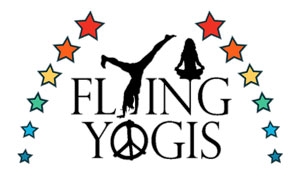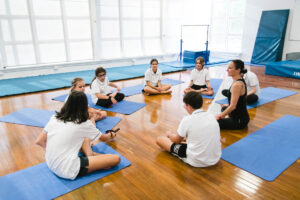
Flying Yogis
Yoga & Acrobatics for Kids
Week 7 OUTLINE
HERE IS A GUIDE ON HOW TO STRUCTURE YOUR YAMAS LESSON.
CLASS INTRO (15 MINS)
ACTIVITY 1: LINKED TO SOCIAL TOPIC (15 MINS)
ACTIVITY 2: LINKED TO PHYSICAL TOPIC (15 MINS)
CONCLUSION AND MEDITATION (10 MINS)
THIS WEEKS SOCIAL FOCUS IS : Respectful Relationships (Social Awareness)
THIS WEEKS PHYSICAL FOCUS IS : Team-work and Collaboration
1. CLASS INTRO - 15 MINS
A. WELCOME CLASS AND INTRO TO TOPIC- 5 mins
GET THE GROUP SEATED AND FOCUSED, INTRODUCE YOURSELF AND SESSION RULES.
UNDERSTANDING RESPECTFUL RELATIONSHIPS
Treating someone with respect means that you interact with them in a way that shows that you care about their well-being and how they feel. When you respect someone, you treat them kindly and use good manners. Sometimes it means doing things for them or listening to their instructions.
SOCIAL AWARENESS
Social awareness involves the ability to understand and empathize with others, particularly with people from different backgrounds than one’s own. … Demonstrating empathy and compassion. Showing concern for the feelings of others.
UNDERSTANDING TEAMWORK + COLLABORATION
Both teamwork and collaboration involve a group of people working together to complete a shared goal.
Why is it important to work as a team?
It helps us problem-solve. …Collaboration brings people closer together. … Collaboration helps people learn from each other. … It makes us feel included… We can achieve more together than alone. It feels good to achieve something with friends!
B. COMPLETE JOURNAL OR WORKSHEET- 5 mins
NO LONGER THAN 5 MINS
Stick in and complete necessary worksheet, write thoughts and topic definition (worksheet will say the weeks social skill and the weeks physical skill)

C. Quick 5 pose stretch/warm up:- 5 mins
NO LONGER THAN 5 MINS
(5 new poses or stretches each week) Salutes if desired
2. SOCIAL TOPIC GAME/ ACTIVITY (15 min)
Topic- Respectful Relationships (Social Awareness)
There are 3 activity options below, select the one best suited to your age group. If you have spare time feel free to complete 2+ activities with your group.
A. WE ARE ALL DIFFERENT AND THE SAME
What you need: Paper and a pen
Instructions:
1. Create groups of five people and give each group two sheets of paper.
2. On one sheet, ask the group to list something the entire group has in common, (try to encourage deeper similarities than just physical i.e: opinions, hobbies etc)
3. On the other sheet of paper, ask the group to list at least two unique qualities of each person in the group. Again, it should not be something that is obvious or that everyone can see, but a characteristic.
4. Differences and similarities are a great thing to celebrate, the group who can list more in the time limit wins.
Benefits:
This activity serves to create respect as people realize their commonalities, learn something new about each other, and focus on their uniqueness. Students also learn to respect and appreciate differences and similarities.
B. RESPECTING and Listening to peers - Simon says
Instructions:
1. Played just like the normal game of Simon Says
2. Give different children a turn at being Simon
3. Encourage ‘Simon’ to only speak politely and only ask for nice tasks
Lessons Learnt:
Explain how everyone had done a great job at listening to a respecting the leader- Explain how in healthy relationships we need to listen to one another, noone is “Simon” all the time
C. Think of ANOTHER GAME
Video guides below if available
3. PHYSICAL SKILL- GAME/ ACTIVITY (15 min)
Topic- Body Awareness
There are 3 activity options below, select the one best suited to your age group. If you have spare time feel free to complete 2+ activities with your group.
A. BLINDFOLDED
Items needed: Blindfolds
Instructions:
1.Students are in pairs and are given a blindfold.
2. A course is set around the room, through hoops, under or around desks.
3. Each student must lead their partner through the course using teamwork to help guide them through the course
Lessons Learnt:
All alone the blindfolded student could not make it through the course, it takes teamwork to navigate difficult challenges
B. PARTNER POSES
Instructions:
1.The children are challenged with a bunch of partner/group acro poses.
2. Start with poses in pairs and work up to full group poses, Have some images printed and ready to demonstrate.
Lessons Learnt:
The kids must work together to complete each pose, without teamwork the kids would fall and fail…
C. BUNNY - ELEPHANT - SNAKE
Instructions:
1. The children are split into 2 teams, they stand in 2 lines and face opposing the other team
2. Explain the rules (Like scissors, Paper, Rock) (Snake eats bunny, Bunny jumps over elephant and escapes, Elephant steps on snake) (teach the pose for each animal)
3. Assigning a team leader to help manage group choice helps (encourage them to listen to one another and work as a team) Decide on 1 of the poses. Kids wait to reveal their choice on the teachers count of 3.
4. Winning team receives a point.
Lessons Learnt:
If the group cannot respect one another and work as a team they a cannot chose a group animal in time, if they are too loud and arguing the other group will hear their selection. All about working in a team
Video guides below if available
4. ENDING DISCUSSION & MEDITATION (10 min)
BRING THE GROUP BACK INTO A CENTRAL CIRCLE, DISCUSS ANY LAST IDEAS OR LEARNINGS FROM THE GAMES AND ANSWER ANY LAST QUESTIONS
Ask the kids what they have learnt and how they will carry these skills into the rest of their week
FINISH WITH A NEW MEDITATION EACH WEEK

This is not a direct script but understand the idea and use it in a meditation style- CHILDREN LAY STILL AND CALM
The world is full of different colours, and you can practice mindfulness by paying attention to which ones you are seeing in the present moment. We rely heavily on our sense of sight, making it a powerful tool for the cultivation of mindfulness.
You can do this practice anywhere. Sitting up laying down or in a car.. Let’s do one now together and you can try it alone later in your week.
Arrive in the present moment.
Take a few mindful breaths, feel the body where it is, and allow your energy to settle.
Pick one color to focus on.
You may try starting with red one day, and work your way through the traditional rainbow spectrum on each subsequent day. Focusing On The Colors You See, Find one thing you can see that is the color you have picked. Look at it with a beginner’s mind, as if you have never seen this thing before. Note what it is and its size and shape. After a few moments, look for something else that is this color. Observe this object in the same way. Continuing with this practice, notice when your mind wanders off. You can always return to the sensation of breathing, using the breath as the anchor for your awareness. You may find it helpful to mentally note exactly what you are seeing. For example, a red stop sign doesn’t get labeled “red stop sign”; it becomes “red, octagon, writing, metal.”
When 10 minutes have passed, allow the eyes to close for a moment.
Take a few deep breaths, let go of the practice, and return to your daily life.
5. GAME SUGGESTIONS FOR IF YOU HAVE EXTRA TIME
© Copyright - Flying Yogis